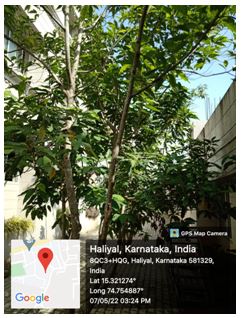KLS, VISHWANATHRAO DESHPANDE INSTITUTE OF TECHNOLOGY, HALIYAL
Knowledge is Power

Scientific Name: Magnolia Champaca/ Michelia Champaca
Medicinal Uses:
- Champaka tree rich in medicinal properties is used in several ayurvedic preparations. The leaves, root, root bark, flowers, fruit and oil are used for its medicinal value. The extract of the flowers, leaves and seeds have anti cancer, antimicrobial, antioxidant properties. The active constituents of the plant are alkaloids, saponins, tannins, sterols, flavonoids and triterpenoids.
- Leaves: Leaves contain volatile oil. Leaves act as anti-inflammatory agents, thus effective in treating swellings. The juice of the leaves along with honey is an antidote for colic pain in infants. The decoction of the leaves is effective for treating arthritis, angina and pharyngitis (inflammation of the pharynx, region behind the throat).
- For arthritis, crushed leaves are mixed with castor oil and applied on affected joints. Leaf juice is used to treat intestinal worms. The leaves are the richest source of ß-sitosterol an important plant sterol (subgroups of the steroids). ß-sitosterol is used to treat benign prostatic hyperplasia. Leaves also possess chemopreventive and adaptogenic properties. Leaves are effective in treating intestinal worms.
- Flowers: The flowers possess antipyretic, anti-inflammatory, insecticidal, antimicrobial, and leishmanicidal activities. A concoction of the flowers is used to treat nausea, fevers and dyspepsia (pain or a vague discomfort in the upper part of the abdomen caused due to gas formation). The flavonoids in the flowers make an excellent cure for rheumatism. A paste of the flowers is effective in treating rheumatism gout and vertigo. The buds of the flowers are used to treat diabetes and renal diseases. An extract of the flowers are rich in antioxidant and antimicrobial activities. An extract of the flowers along with dexamaethasone hastens the healing of the wounds. This could be applied on the wound or taken internally to hasten the healing of the wound.
- The flowers are also effective as a plaster on stomach to treat colic pain. A mixture of the unopened buds taken internally is effective in treating gonorrhoea.
- Flowers and leaves are effective in treating ulcers. Flowers are effective in treating cardiac associated diseases, leprosy, post partum protection and in eye disorders.
- Bark: The bark contains volatile oil, fixed oil, resin, tannin, mucilage, starch and sugar. The powder of the bark is used as antipyretic (reduce fever), and as a diuretic. An extract of the bark is used to treat diabetes related complications. The bark is also effective in treating tumours.
- Seeds: Seeds are effective in treating rheumatism and for healing the cracks in the soles of the feet.
- Root: Root is purgative (laxative) and the root-bark, emmenagogue, (stimulate blood flow in the uterus, pelvic region, cause menstruation) and demulcent (an agent that provides a cooling or a soothing effect over the mucus membrane, relieves pain or inflammation).
- Other uses: The oil of the flowers is used extensively in perfumes. The flowers are also used for perfuming clothes in storage, for the purposes of decoration during religious or social ceremonies. The flowers are used to scent hair oils.
- Grind champa flowers and apply it on the skin affected with leprosy. A few drops of this flower destroy the germs present in the blood. Dry the flowers and make a fine powder, use this powder to get relief from itching. Champa cures fever, improves the eyesight and gives strength and energy to men.
- Other uses
- Gain physical strength
- Relieve nervousness
- Decreased bile
- For masculinity
- Illuminate eyesight
KLS, VISHWANATHRAO DESHPANDE INSTITUTE OF TECHNOLOGY, HALIYAL is proudly powered by WordPress